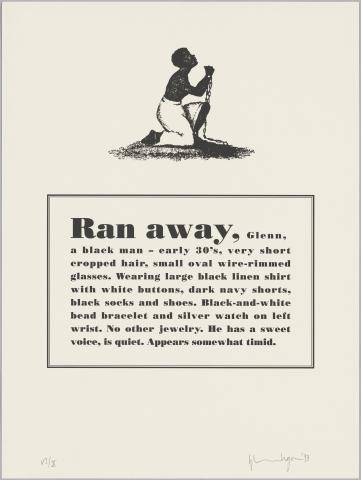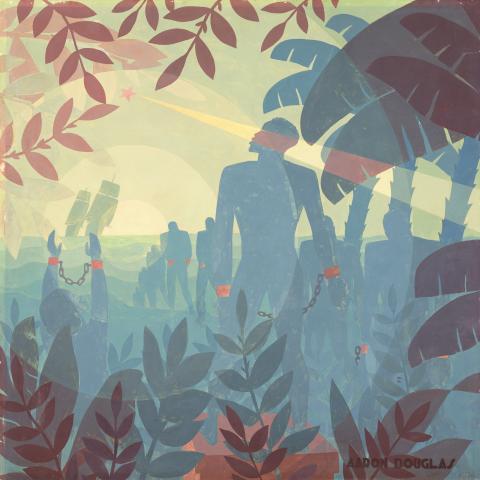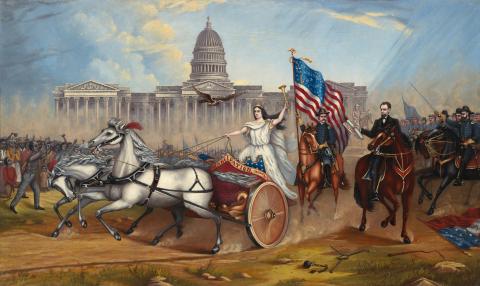Afro Atlantic Art: Enslavements and Emancipations

Aaron Douglas, Into Bondage, 1936
Courtesy National Gallery of Art
This resource, provided courtesy of the National Gallery of Art, presents a variety of artworks, from the 17th century to the present, that highlight the presence and experiences of Black communities across the Atlantic world (the relationships between people of the Americas, Africa, and Europe). Use the pieces in this collection to engage your students in conversation about the many and continuing legacies of the transatlantic slave trade as told through art.
Find related artwork and activities in the EDSITEment Teacher's Guide Arts of the Afro Atlantic Diaspora.
Kerry James Marshall, Voyager, 1992
Kerry James Marshall, Voyager, 1992, acrylic and collage on canvas, National Gallery of Art, Washington, Corcoran Collection (Gift of the Women’s Committee of the Corcoran Gallery of Art), 2014.79.52
Marshall’s Voyager, depicting two partially obscured Black figures standing aboard a ship, refers to an actual ship, Wanderer. The Wanderer was among the last slave ships in the United States, illegally transporting more than 400 individuals from West Africa to Georgia in 1858—even though the importation of enslaved people had been banned in 1808.
Marshall, as both an artist and professor, is known for his large-scale historical scenes that highlight subjects and events often omitted from European and North American art history. Symbolism plays a significant role in many of his paintings, and Voyager has several symbolic details, such as deceased fetuses, a skull, and vévés (geometric drawings) and the number 7, both symbols of Vodou, a religion typically practiced in Haitian Diasporic communities with both African and European origins.
- Why do you imagine Marshall might have chosen this scene of the Middle Passage as his subject?
- Where else today can we see traces and reminders of the transatlantic slave trade?
Extend your discussion with the companion lesson plan Afro Atlantic: Mapping Journeys.
John Raphael Smith, after George Morland, Slave Trade, 1791
John Raphael Smith, after George Morland, Slave Trade, 1791, mezzotint, National Gallery of Art, Washington, Paul Mellon Fund, 2001.118.62
Slave Trade is a print based on George Morland’s 1788 original painting of this scene. In a setting on an African coast, a fictional African family is separated and enslaved by European sailors. Though this scene is imagined, Morland drew from descriptions of enslavement that circulated in the news at the time. Morland was among the first to produce a scene of the slave trade.
By the time Smith produced this print in 1791, the European antislavery movement was reaching a peak, and images such as this were used by abolitionists to elicit a strong response. Smith added an emotionally charged caption: “lo! The poor Captive with distraction wild / Views his dear Partner torn from his embrace! / A diff’rent Captain buys his Wife and Child / What time can from his Soul such ills erase?” The British transatlantic slave trade was banned in 1807, but it would still be decades until slavery itself was abolished in the United Kingdom.
- What emotions are captured in the expressions of the individuals in this scene?
- What emotions do the image and its caption elicit in you?
- Can you think of examples of art or images from today that are used to provoke action on pressing issues? What are they?
Glenn Ligon, Runaways, 1993
Glenn Ligon, Runaways, 1993, 10 lithographs, National Gallery of Art, Washington, Gift of the Collectors Committee and Luhring Augustine Gallery
In this series of lithographs, artist Glenn Ligon recreates “runaway” advertisements published in antebellum newspapers. The text of each lithograph is based on how Ligon’s friends chose to describe him if he went missing. While the descriptions focus largely on Ligon’s physical features, they also include specific notes about his personality and behaviors, as did many 19th-century fugitive notices. While running away was a form of self-emancipation for enslaved people, it did not guarantee self-determination. As Ligon states, “Runaways is broadly about how an individual’s identity is inextricable from the way one is positioned in the culture, from the ways people see you, from historical and political contexts.”
- How does the way you see yourself compare to what others think of you?
- What assumptions might people make when they first meet you?
- Are there any assumptions that you automatically make when you first meet people?
Explore the Freedom on the Move database to search for descriptions of individuals classified as fugitives. Can you find any mentions of your state in the database?
Aaron Douglas, Into Bondage, 1936
Aaron Douglas, Into Bondage, 1936, oil on canvas, National Gallery of Art, Washington, Corcoran Collection (Museum Purchase and partial gift from Thurlow Evans Tibbs, Jr., The Evans-Tibbs Collection), 2014.79.17
Into Bondage is a powerful depiction of Africans being forcibly enslaved to be taken to the Americas. Shackled figures walk toward slave ships on the horizon, and an individual at left raises their bound hands. The figure in the center is turned toward a beam of light emanating from a lone star in the sky, possibly suggesting the North Star. The concentric circles are a motif frequently used by Aaron Douglas to suggest sound, particularly African and African American song.
In 1936, Douglas, considered a leader of the Harlem Renaissance, was commissioned to create a series of four murals (of which only two have survived) for the Texas Centennial Exposition in Dallas. Installed in the Hall of Negro Life, his four paintings charted the journey of African Americans from slavery to the present. The Hall of Negro Life opened on Juneteenth (June 19), a date celebrating the end of slavery.
- What rights had Black Americans gained by the 1930s, the time when Douglas made this mural series? What rights and freedoms did they have yet to gain?
- Why do you think Juneteenth, a commemoration of the abolition of slavery, is important to celebrate?
Extend your discussion with the companion lesson plan Afro Atlantic: Paths from Enslavement.
A. A. Lamb, Emancipation Proclamation, 1864 or after
A. A. Lamb, Emancipation Proclamation, 1864 or after, oil on canvas, National Gallery of Art, Washington, Gift of Edgar William and Bernice Chrysler Garbisch, 1955.11.10
A.A. Lamb's Emancipation Proclamation presents an imaginary scene set against the east façade of the US Capitol in Washington, DC. The goddess of Liberty, driving a chariot, leads Abraham Lincoln and his officers, who are followed by Union army cavalry. The full-bearded, sword-wielding general at the right resembles Ulysses S. Grant. In this scene, people presumed to be newly emancipated, formerly enslaved individuals are relegated to the background, showing gestures of gratitude toward the white figures, who occupy more central positions. This is the only known artwork from Lamb, who is believed by art historians to have been a sign-maker or painter possibly in New York.
- Who do you think the audience for this painting might be?
- Who are being portrayed as the heroes of this story? What details help you draw this conclusion?
Extend your discussion with the companion lesson plan Afro Atlantic: Exploring Emancipation.
This resource is drawn from the content of the Afro-Atlantic Histories exhibition organized by the Museum of Fine Arts, Houston, and the Museu de Arte de São Paulo in collaboration with the National Gallery of Art, Washington. All related materials found on EDSITEment have been provided courtesy of the National Gallery of Art, Washington.





